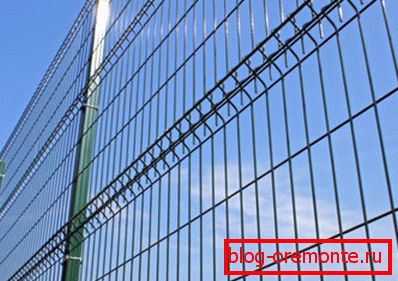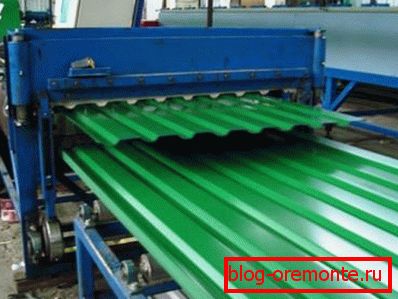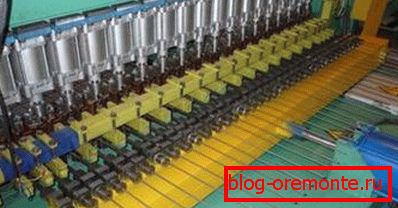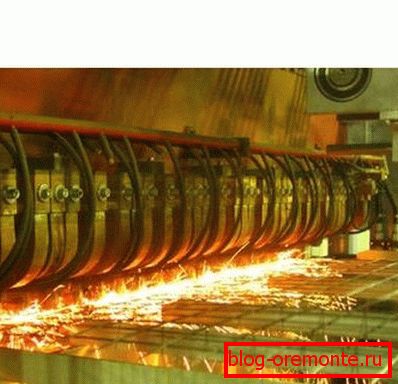Production fences and modern technology
Manufacturers of fences are striving to apply more and more effective methods of manufacturing their products, using new materials and advances in science.
The goal is to reduce the cost of production and the final product as much as possible, to make it more accessible to the consumer, and also to achieve the most convenient operating conditions at all stages of use.

Modern designs are different technological way of production.
Technologies and their features
Profiled sheet

Sheet profiled metal is one of the most used materials in the production of modern fencing systems.
If we talk about modern and current designs of barriers, first of all it is worth mentioning such a material as a profiled metal sheet.
This material is a sheet steel, corrugated on a rolling machine to give the product a more rigid shape. Profiling increases stiffness rates, which allows the use of a thinner metal, and this reduces the cost of the product.
Кроме того, возможность использования тонкого листа значительно уменьшает вес изделия, что, в свою очередь, позволяет применять более легкие и дешевые крепления, столбы для забора, лаги etc. Таким образом, удешевляется и упрощается вся система, снижается цена конечного изделия, что и было основной целью.

Sheet steel coated with zinc in the amount of 120 - 180 mg / m ?.
The process of making a professional sheet:
- Before corrugation, the sheet is electroplated and coated with zinc. The zinc layer prevents the occurrence of electrochemical corrosion, and also protects the metal from interaction with oxygen and oxidation, reactions with aggressive media and other undesirable substances;
- Next, the sheet is coated with a polymeric powder dye. To do this, the surface is treated with special compounds (oxides) and sent to the spray booth;
- In the chamber, a sheet is connected to an installation that tells it a charge of a certain value. The charge creates an electrostatic field, which affects the dust particles sprayed in the chamber, and they are attracted to the surface of the product;
- The result is an even coating, the thickness of which is strictly calculated. Next, the sheet is sent to a special oven, without disconnecting from the source of charge. In the furnace, the dye is heated and polymerized, forming a monolithic hermetic coating, similar to automotive enamel;
- After that, the product is cut and crimped on a rolling machine. The result is a thin, light, but durable sheet that is not afraid of precipitation, solar radiation, corrosion, moisture, etc .;
- This technology provides a large selection of colors and shades, which is also very appreciated by the consumer and allows the harmonious adaptation of the fence to the house and landscape design style.

In the photo powder polymeric dye, which is sprayed onto the surface of sheet steel.
Important! Profiled sheets are different. For fences and walls use thick sheets of grade C8, where the figure 8 indicates the height of the wave, which is directly proportional to the rigidity of the product. For roofs and other coatings use other brands, so when you purchase you need to choose the right model.
Profiled sheet is used as an independent building material, and is also widely used in the manufacture of modular fences, combined fences, walls of hangars and workshops, trade pavilions and warehouses.
Welded mesh

Steel welded mesh coated with polyvinyl chloride.
Another popular and widely used material is welded mesh. Without it, the production technology of pre-fabricated fences would be incomplete.
The product is quite simple: a system of perpendicular metal rods, welded at intersections.
Production of small volumes of such products is quite possible with our own hands without the use of automation, however, in market conditions, it is expedient to use conveyor-made large volumes that can satisfy the growing demand for goods.

Machine for the production of welded steel mesh.
The degree of automation of production depends on the diameter of the original semi-finished product. For various types of mesh use rebar, rod or wire.
In the case of thick reinforcement, the metal is cut into measured lengths, which are placed in the trays of the welding conveyor. Next, the machine forms a set of longitudinal rods, which the machine lays with the necessary step.

The longitudinal bars laid by the machine from armature.
Further along the laid pieces, the second tray moves, which feeds and lays out the transverse rods. The instruction and sequence of actions, like the general kinematics of the equipment, may differ depending on the model and design of the conveyor.
After the transverse rod touches the longitudinal, the segments are fixed and subjected to resistance welding.

The process of contact welding of steel rods in the production of welded mesh.
Important! For contact or spot welding is highly undesirable the presence of rust, dirt or mechanical defects. Therefore, marriage often occurs. When buying a welded mesh, check the quality of welding at the intersection of the rods.
In the case of wire, the whole process is fully automated: the raw material is unwound from the bay continuously, and the transverse parts are cut and fed synchronously by an automatic machine. Next is welding.
The finished mesh is covered with a polymeric protective layer or paint, stiffening ribs are attached to it and delivered to shops and businesses that use it to produce panel-type fences.
Benefits

Combined brick and professional railing.
Welded mesh and profiled sheets are used for the manufacture of modern modular and panel-type fencing systems.
These materials have the following advantages:
- Low material consumptionthat has a positive effect on the price;
- A light weightthat allows the use of mechanical fasteners and lightweight supporting structures;
- High strength and stiffness;
- Inertness and resistance to aggressive environments and corrosionas a result - durability;
- Easy to install, cut and transport;
- Wide decorative features, colors etc.
Conclusion
Obviously, the manufacturer to strive to use advanced technologies and materials. The final product becomes cheaper and more affordable, and the old and traditional materials and methods of production gradually disappear. In the presented video in this article you will find additional information on this topic.